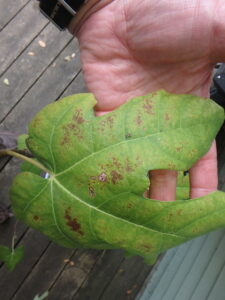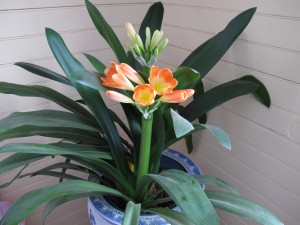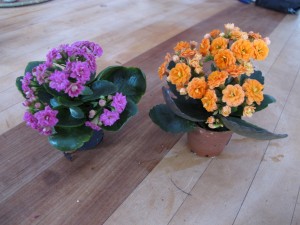Have Happy Houseplants in Summer
But even plants that thrive outdoors in full sun need to be introduced to the outdoors slowly. I have a potted fig tree that I bring into the house each winter. It drops its leaves and takes a snooze, so I keep it in a cold basement, which it seems to like. I water it once a month during the winter as the low humidity indoors would desiccate its roots if I didn’t give it a little water. Then in March I bring the fig upstairs into a cool, bright room. Soon its buds swell, and it produces leaves.
If you are interested in growing figs, you should get a copy of Lee Reich’s book, “Growing Figs in Cold Climates”. It covers cultivar selection, over-wintering and pruning techniques, even how to tell when your figs are ripe. It’s in paperback and is fully illustrated with nice photos. Lee lives in upper New York State, and was an Associated Press garden writer until he recently retired. Check out his website and blog at https://www.leereich.com.
If you have your houseplants outdoors, be sure that they are not getting over-watered by Mother Nature. When we got an inch and half of rain I went around to look at my houseplants that are sitting in saucers and drained off excess water. Water in a saucer will get soaked up into a pot by capillary action – or even greedy roots that sneak out through holes in the bottom of a pot. Most houseplants don’t need as much water as garden plants, and continually wet roots tend to rot.
House Plants That Are Really, Really Easy
I recently went over to a houseplant and gave it praise. I said, “Thank you clivia, for producing flowers for me. I know I don’t deserve them because I don’t do anything for you. I don’t even wipe the dust off your beautiful green leaves. You are so undemanding that sometimes I’ve gone a whole month without watering you – and didn’t wilt or complain. And now you are beginning to flower. Thank you.” I really did say that. And I meant it.
Clivia, also known as Kaffir lily, is a plant that comes from South Africa where it lives in deep forests with low light conditions and survives much of the year without rain. So it is an ideal houseplant. It has18-24-inch glossy strap-like leaves and once a year it produces a tall flower stalk with a cluster of orange blossoms. I haven’t done anything for mine, and it has produced two more plants, offsets from the parent plant. And now one of those two offsets is preparing to bloom, too.
But bloom time is unpredictable for my clivia. Keeping it quite dry in the winter in a cold room and then giving it a little liquid fertilizer now is supposed to help it wake up and bloom. I’ve never given mine fertilizer, and still it blooms. One year it bloomed in August and won a blue ribbon at the Cornish Fair.
I like keeping an aloe plant in the house to use occasionally on a burn or a bothersome bug bite. You have bought hand lotion with aloe vera in it, I’m sure. The aloe plants available for purchase have similar healing properties – just cut off a leaf and rub the cut surface on a burn, spreading its juices. Again, I do nothing for it. It sits in a north window, getting little or no direct sunlight. And it only gets watered very occasionally. Yet it has survived for 25 years or so. Benign neglect.
At the Vermont Flower Show I bought some perky little plants that I’ve had before: kalanchoe. Think energizer bunny. They are commonly sold in grocery in 2-inch pots, loaded with little pink or yellow or orange blossoms. And they just keep on blooming, for months, it seems. I keep mine on a morning-sun windowsill, and do actually give them water once a week. If I forget to water they droop, but quickly recover with a good soaking. I only paid $3.99each and they keep blooming. What’s not to like?
Then there is the pony tail palm (Beaucarnea recurvata). This is a houseplant that reminds me of a soccer ball in a pot, topped with a woody stem and a big head of green strap-like leaves thrown off in all directions. I keep mine in a 12-inch deep pot and still the leaves are so long they hang down to the table.
In the summer I leave my ponytail palm on the deck where it gets a few hours of sunshine each day. In the winter I keep it in a west-facing window and only water once a month or so – the bulbous base stores water, and it goes somewhat dormant in winter anyhow.
Swedish ivy (Plectranthus sp.) is another “you can’t kill me” plant. It is not an ivy, but does make long stems that will hang down and out of a pot. The leaves of mine are all green with purplish stems. Occasionally it will produce tiny light blue flowers.
The great thing about Swedish ivy is that it is so easy to start new plants. Just cut off a few stems, put in a jar of water, and they will root. Then pot a group of them up for a nice pot of foliage. It does like more water than the other plants discussed above, but it always recovers if I let it dehydrate. It can appear dead, but so far, mine has always bounced back.
The last of my favorite tough-as-a nail house plants is crown of thorns (Euphorbia milii). I have one that is at least a hundred years old, so you know that it has had some rough treatment in its day. I don’t like the thorns, but I do like that it produces dozens of nice small bright red flowers all winter in a west-facing window. Like the others, it never seems to complain when I ignore it.
The worst thing you can do for most houseplants is to water too often. Most reliable, rock-solid houseplants come from the tropics, often from South Africa. Most can go a month or more without water – it’s what they have to survive in the wild.
I don’t fertilize houseplants. In nature no one comes along with liquid fish juice or a chemical solution to “help” them. Fertilizer will push growth – but I don’t need bigger house plants. I need easy houseplants – and probably a few less than I have. Re-potting helps many houseplants, but those I mentioned above I have never re-potted, either. Crown of thorns is too prickly. I’ve read that clivia roots are almost impossible to pull apart. So I just say thanks to my plants, or offer them a few words of encouragement, and they do just fine.
Henry’s newest book, Wobar and the Quest for the Magic Calumet is a children’s chapter book about a boy born with a magical mustache and the ability to speak to animals. Learn more at www.henryhomeyer.com. Reach Henry at henry.homeyer@comcast.net.








